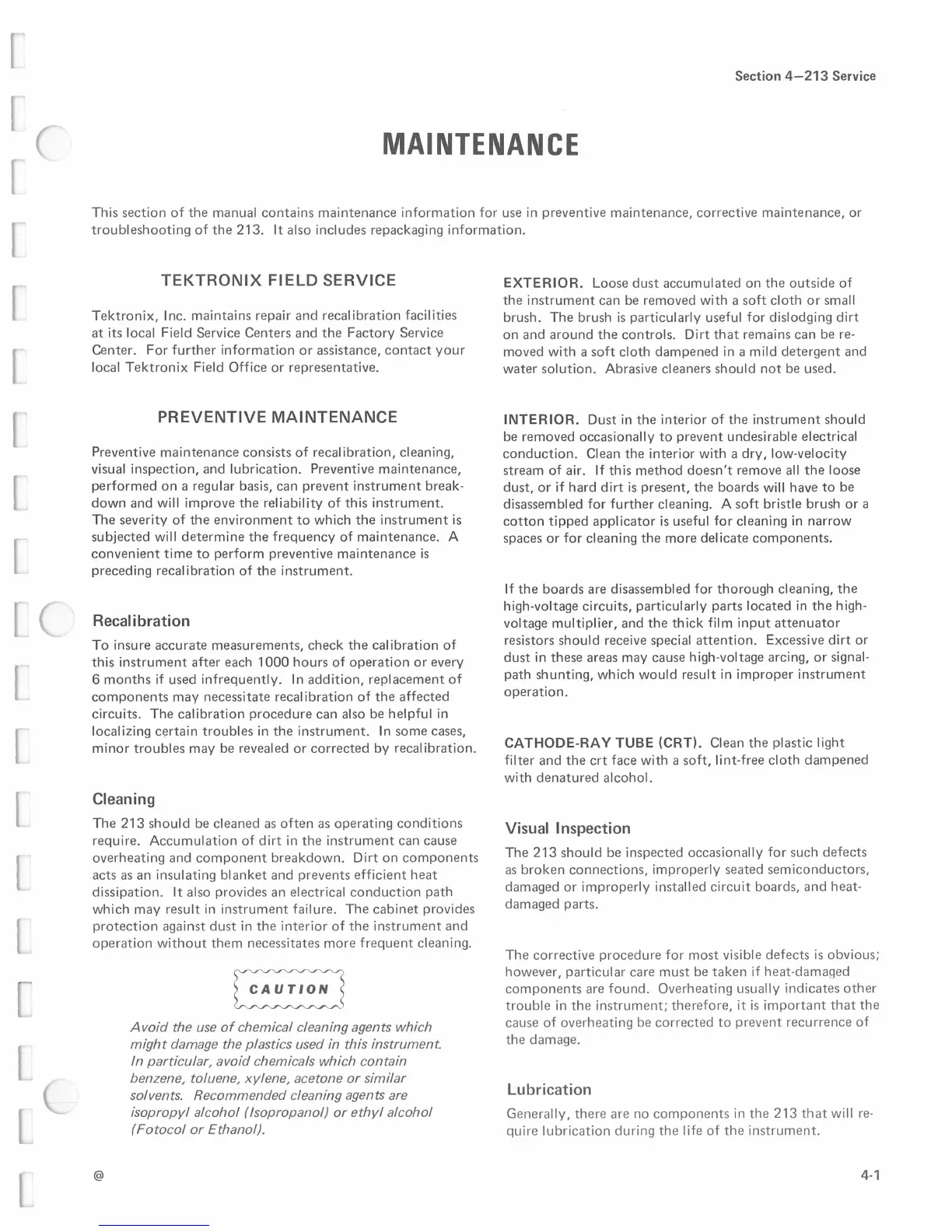Section
4-213
Service
MAINTENANCE
This
section
of
the
manual
contains
maintenance
information
for
use in
preventive
maintenance,
corrective
maintenance,
or
troubleshooting
of
the
213. It
also
includes
repackaging
information.
TEKTRONIX
FIELD
SERVICE
Tektronix,
Inc.
maintains
repair
and
recalibration
facilities
at
its local
Field
Service
Centers
and
the
Factory
Service
Center.
For
further
information
or
assistance,
contact
your
local
Tektronix
Field
Office
or
representative.
PREVENTIVE
MAINTENANCE
Preventive
maintenance
consists
of
recalibration,
cleaning,
visual
inspection,
and
lubrication.
Preventive
maintenance,
performed
on
a regular basis,
can
prevent
instrument
break-
down
and
will
improve
the
reliability
of
this
instrument.
The
severity
of
the
environment
to
which
the
instrument
is
subjected
will
determine
the
frequency
of
maintenance.
A
convenient
time
to
perform
preventive
maintenance
is
preceding
recalibration
of
the
instrument.
Recalibration
To
insure
accurate
measurements,
check
the
calibration
of
this
instrument
after
each
1000
hours
of
operation
or
every
6
months
if
used
infrequently.
In
addition,
replacement
of
components
may
necessitate
recalibration
of
the
affected
circuits.
The
calibration
procedure
can
also
be
helpful
in
localizing
c~rtain
troubles
in
the
instrument.
In
some
cases,
minor
troubles
may
be
revealed
or
corrected
by
recalibration.
Cleaning
The
213
should
be
cleaned
as
often
as
operating
conditions
require.
Accumulation
of
dirt
in
the
instrument
can
cause
overheating
and
component
breakdown.
Dirt
on
components
acts
as
an
insulating
blanket
and
prevents
efficient
heat
dissipation.
It
also
provides
an
electrical
conduction
path
which
may
result
in
instrument
failure.
The
cabinet
provides
protection
against
dust
in
the
interior
of
the
instrument
and
operation
without
them
necessitates
more
frequent
cleaning.
@
E3
A void the use
of
chemical cleaning agents which
might damage the plastics used in this instrument.
In
particular, avoid chemicals which contain
benzene, toluene, xylene, acetone or similar
solvents. Recommended cleaning agents
are
isopropyl alcohol ( lsopropanol) or
ethyl
alcohol
(Fotocol or Ethanol).
EXTERIOR.
Loose
dust
accumulated
on
the
outside
of
the
instrument
can
be
removed
with
a
soft
cloth
or
small
brush.
The
brush
is
particularly
useful
for
dislodging
dirt
on
and
around
the
controls.
Dirt
that
remains
can
be
re-
moved
with
a
soft
cloth
dampened
in a mild
detergent
and
water
solution.
Abrasive
cleaners
should
not
be
used.
INTERIOR.
Dust
in
the
interior
of
the
instrument
should
be
removed
occasionally
to
prevent
undesirable
electrical
conduction.
Clean
the
interior
with
a
dry,
low-velocity
stream
of
air. If
this
method
doesn't
remove
all
the
loose
dust,
or
if
hard
dirt
is
present,
the
boards
will
have
to
be
disassembled
for
further
cleaning.
A
soft
bristle
brush
or
a
cotton
tipped
applicator
is
useful
for
cleaning
in
narrow
spaces
or
for
cleaning
the
more
delicate
components.
If
the
boards
are
disassembled
for
thorough
cleaning,
the
high-voltage
circuits,
particularly
parts
located
in
the
high-
voltage
multiplier,
and
the
thick
film
input
attenuator
resistors
should
receive special
attention.
Excessive
dirt
or
dust
in
these
areas
may
cause
high-voltage
arcing,
or
signal-
path
shunting,
which
would
result
in
improper
instrument
operation.
CATHODE-RAY
TUBE
(CRT).
Clean
the
plastic
light
filter
and
the
crt
face
with
a
soft,
lint-free
cloth
dampened
with
denatured
alcohol.
Visual Inspection
The
213
should
be
inspected
occasionally
for
such
defects
as
broken
connections,
improperly
seated
semiconductors,
damaged
or
improperly
installed
circuit
boards,
and
heat-
damaged
parts.
The
corrective
procedure
for
most
visible
defects
is
obvious;
however,
particular
care
must
be
taken
if
heat-damaqed
components
are
found.
Overheating
usually
indicates
other
trouble
in
the
instrument;
therefore,
it
is
important
that
the
cause
of
overheating
be
corrected
to
prevent
recurrence
of
the
damage.
Lubrication
Generally,
there
are
no
components
in
the
213
that
will re-
quire
lubrication
during
the
life
of
the
instrument.
4-1

